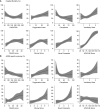Validating Measures of Disease Severity in Acute Respiratory Distress Syndrome
- PMID: 33347379
- PMCID: PMC8328371
- DOI: 10.1513/AnnalsATS.202007-772OC
Validating Measures of Disease Severity in Acute Respiratory Distress Syndrome
Abstract
Rationale: Quantifying acute respiratory disease syndrome (ARDS) severity is essential for prognostic enrichment to stratify patients for invasive or higher-risk treatments; however, the comparative performance of many ARDS severity measures is unknown.Objectives: To validate ARDS severity measures for their ability to predict hospital mortality and an ARDS-specific outcome (defined as death from pulmonary dysfunction or the need for extracorporeal membrane oxygenation [ECMO] therapy).Methods: We compared five individual ARDS severity measures including the ratio of arterial oxygen tension/pressure to fraction of inspired oxygen (PaO2/FiO2 ratio), oxygenation index, ventilatory ratio, lung compliance, and radiologic assessment of lung edema (RALE); two ARDS composite severity scores including the Murray Lung Injury Score, and a novel score combining RALE, PaO2/FiO2 ratio, and ventilatory ratio; and the Acute Physiology and Chronic Health Evaluation IV score, using data collected at ARDS onset in patients hospitalized at a single center in 2016 and 2017. Discrimination of hospital mortality and the ARDS-specific outcome was evaluated using the area under the receiver operator characteristic curve (AUROC). Measure calibration was also evaluated.Results: Among 340 patients with ARDS, 125 (37%) died during hospitalization and 36 (10.6%) had the ARDS-specific outcome, including one who received ECMO. Among the five individual ARDS severity measures, the RALE score had the highest discrimination of the ARDS-specific outcome (AUROC = 0.67; 95% confidence interval [CI], 0.58-0.77), although other ARDS severity measures had similar performance. However, their ability to discriminate overall mortality was low. In contrast, the Acute Physiology and Chronic Health Evaluation IV score best discriminated overall mortality (AUROC = 0.73; 95% CI, 0.67-0.79) but was unable to discriminate the ARDS-specific outcome (AUROC = 0.54; 95% CI, 0.44-0.65). Among ARDS composite severity scores, the lung injury score had an AUROC = 0.67 (95% CI, 0.58-0.75) for the ARDS-specific outcome whereas the novel score had an AUROC = 0.70 (95% CI, 0.61-0.79). Patients grouped by quartile of the novel score had a 6%, 2%, 10%, and 24% rate of the ARDS-specific outcome.Conclusions: Although most ARDS severity measures had poor discrimination of hospital mortality, they performed better at predicting death from severe pulmonary dysfunction or ECMO needs. A novel composite score had the highest discrimination of this outcome.
Keywords: acute respiratory distress syndrome; critical care; critical care outcomes; mechanical ventilation; quality improvement.
Figures

References
-
- Ferguson ND, Fan E, Camporota L, Antonelli M, Anzueto A, Beale R, et al. The Berlin definition of ARDS: an expanded rationale, justification, and supplementary material. Intensive Care Med. 2012;38:1573–1582. - PubMed
-
- Bernard GR, Artigas A, Brigham KL, Carlet J, Falke K, Hudson L, et al. The American-European Consensus Conference on ARDS: definitions, mechanisms, relevant outcomes, and clinical trial coordination. Am J Respir Crit Care Med. 1994;149:818–824. - PubMed
-
- Ranieri VM, Rubenfeld GD, Thompson BT, Ferguson ND, Caldwell E, Fan E, et al. ARDS Definition Task Force. Acute respiratory distress syndrome: the Berlin Definition. JAMA. 2012;307:2526–2533. - PubMed
Publication types
MeSH terms
Grants and funding
LinkOut - more resources
Full Text Sources

